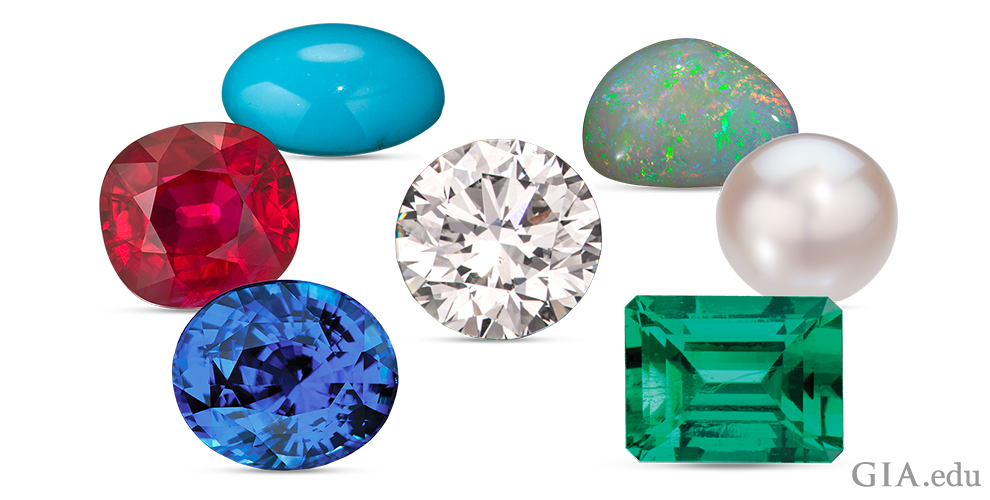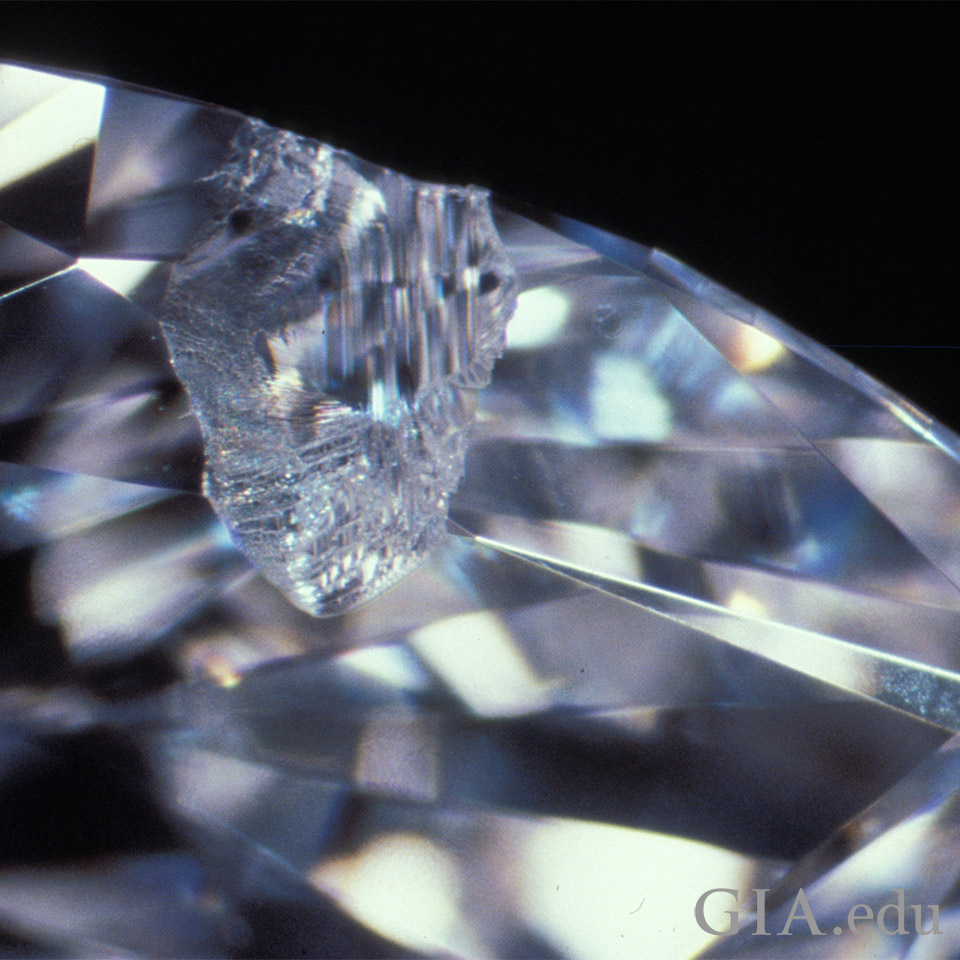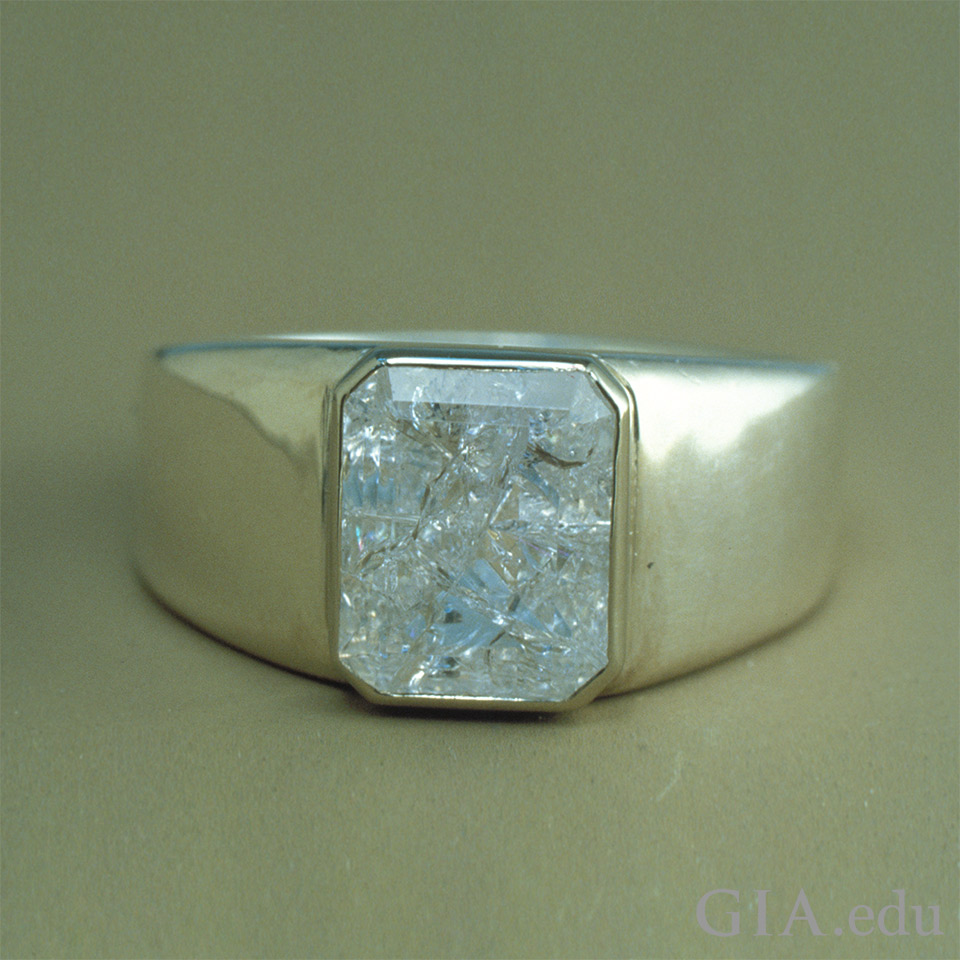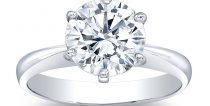As you’re shopping for fine jewelry, knowing how durable a particular gemstone is will help you determine how and when to wear it, and most importantly – how to care for it. In this post, we’ll go beyond the Mohs scale to demystify gemstone durability and provide tips for helping you choose a gemstone that could last a lifetime or longer.
You may have heard of the Mohs scale, which ranks gem and mineral hardness on a scale of 1 (least hard – talc) to 10 (hardest of all – diamond). But hardness is only one factor in determining gem durability.
Gemologists define durability as a gemstone’s ability to withstand wear, heat, light, household chemicals, and low or high humidity. Since different gemstones have different properties, they have varying tolerances to these stressors. In evaluating a gemstone’s durability, gem experts consider three factors: 1) hardness, 2) toughness, and 3) stability. No single gemstone scores a “perfect 10,” so you should weigh all three of these factors when choosing which gemstone or piece of jewelry is right for you.

Diamond is the hardest gemstone, but not necessarily the toughest. While they resist scratching and abrasions, diamonds can be cleaved or fractured by a hard blow. Photo: Kevin Schumacher/GIA.
1. Gemstone Hardness = resistance to scratches and abrasions
A gemstone’s hardness is a good indicator of how well it will resist scratches and abrasions. The Mohs scale is a not a linear scale. Instead it ranks gems on a relative scale based on their scratch hardness, so although corundum (ruby or sapphire) is a 9, a diamond at 10 is many times harder. Only a diamond can scratch a diamond. Corundum can scratch itself, topaz (8), quartz (7), and anything softer. Topaz can scratch itself, quartz (7), and anything lower on the scale.
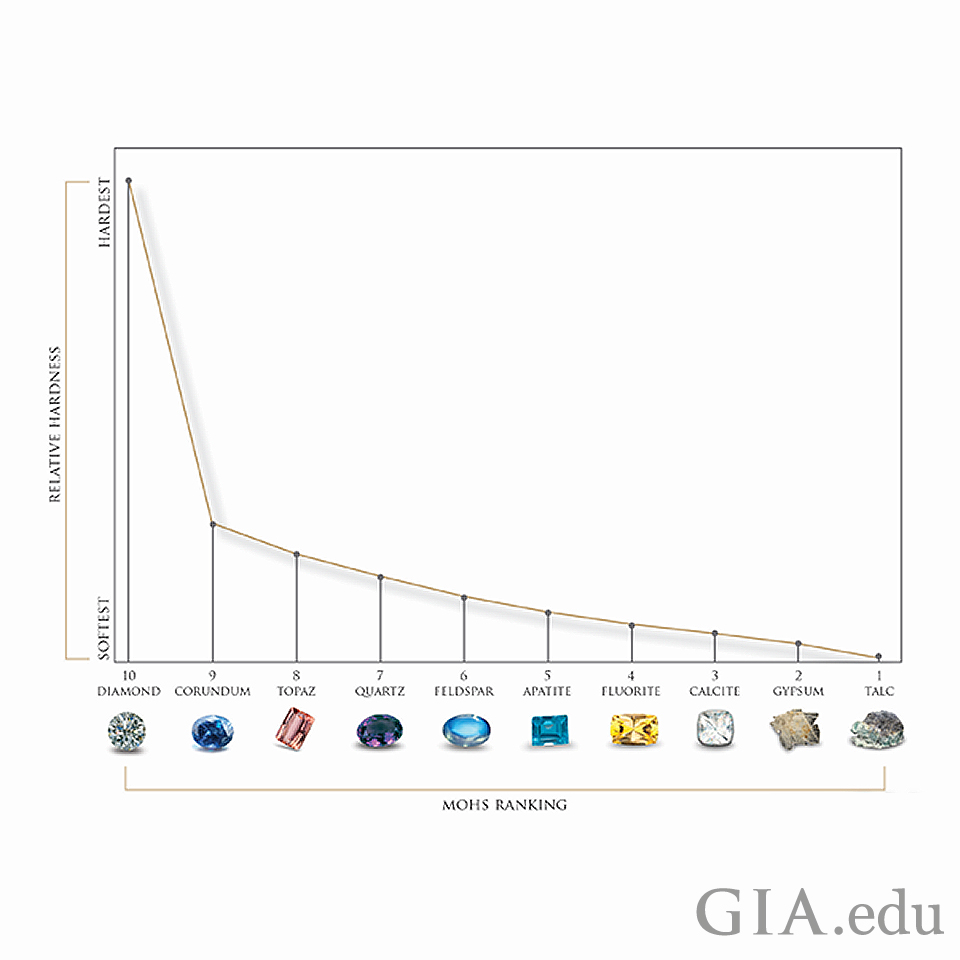
Introduced in 1822, the Mohs hardness scale originated when Friedrich Mohs chose ten minerals and assigned numbers to them based on the relative ease or difficulty with which one can be scratched by another. His studies resulted in the scale which is still used today. Illustration: GIA.
TIP: You shouldn’t store a diamond next to topaz or any other gem in your jewelry box, as the diamond could scratch it. And you might wear softer gemstones that rank low on the Mohs’ hardness scale on special occasions rather than for everyday wear. Learn more about how to care for your diamond if this gem is in your jewelry box.

Ranked 9 on the Mohs hardness scale, ruby and sapphire are the second hardest gems on the Mohs hardness scale. Photo: Robert Weldon/GIA. Courtesy: Bear Essentials

This 5.63 carat (ct) cushion cut topaz is so rich in color that it’s a visual treat. Topaz, an 8 on the Mohs scale, is harder than quartz, which is a 7, but not as hard as ruby and sapphire. Photo: Robert Weldon/GIA. Courtesy: Pala International.
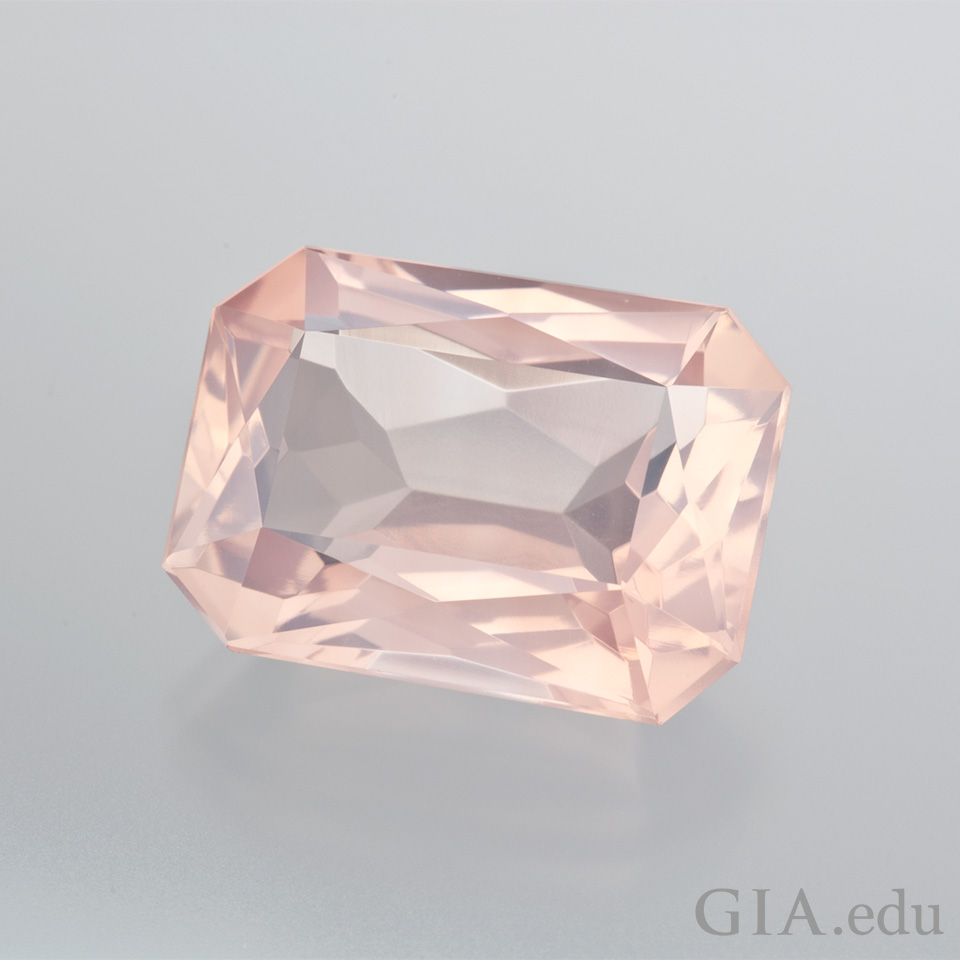
The quartz family of gems is a large one, and with its soft, pastel colors rose quartz is particularly a charming member. Quartz is rated a 7 on the Mohs hardness scale, less hard than topaz, ruby and sapphire. Photo: Robert Weldon/GIA, Dr. Eduard J. Gübelin Collection
2. Gemstone Toughness = resistance to breaking and chipping
The way the atoms of a gem bond together and the strength of these bonds determine a gemstone’s toughness, or how well a gemstone resists breaking and chipping. The toughness scale used in scientific literature is called a fracture toughness scale. The toughness scale measures the work required to separate two surfaces of a crystal along a certain crystallographic plane. Values range from 225,000 for nephrite and 120,000 for jadeite, considered very tough gems, to 600 for corundum, which is not as tough.
Values for diamond generally range from 5,000 along the stone’s cleavage planes to over 8,000. Even though diamonds are considered tough, they can break more easily in certain directions, and a hard blow can cleave or fracture the gem. Diamonds with extremely thin girdles and ones with exposed points like those cut as pears and marquises are susceptible to breakage or chipping.
TIP: Protect not-so-tough gems like opal or tanzanite by choosing types of jewelry less likely to suffer accidental blows. Earrings or necklaces, for example, are a good choice because there is less risk that the gemstones will accidentally hit a hard surface. If you choose to set these gems in a bracelet or ring, reserve these pieces for special occasions.
TIP: Protect gems from chipping by choosing a suitable setting. Vulnerable points or corners are better protected with bezels, partial bezels, or V-shaped prongs.
TIP: Make sure the prongs holding the gem in place are in good shape. Bent or broken prongs can expose vulnerable areas on a gem that could be chipped. A diamond that is loose in its mounting can even cut through the metal prongs and fall out of its setting.
3. Gemstone Stability = resistance to chemicals, heat, humidity and light
Stability refers to how well a gemstone can withstand exposure to chemicals, light, and changes in temperature or humidity. Some key causes of gemstone damage include:
Extreme Temperature Changes
Diamonds are very stable, but sudden and extreme changes in temperature can create fractures and cleavages or cause existing ones to spread. Thermal shock is the term to describe this and results from a sudden change from very warm to very cold temperatures. This sudden temperature change will damage gems such as apatite, iolite, kunzite, opal, and tanzanite.
Thermal shock shattered this diamond. Photo: GIA
Humidity Levels
Other gemstones are susceptible the humidity of their surroundings. Opals can lose moisture in low humidity or when exposed to heat causing them to crack or craze. Vaults and safes are usually very low in humidity and will dry out opals.
On the flip side, long exposure to water can damage some gems, such amber, azurite and malachite.
Prolonged Exposure to Heat and Light
Gemstones like citrine, amethyst, kunzite, and topaz can fade or change color from prolonged exposure to light. Long-term exposure to heat and light can damage most organic gems, like amber, pearls, jet, coral and ivory. Enamel also may be ruined by contact with heat.
Exposure to Chemicals and other Materials
Chlorine, and even perfume and makeup can damage or discolor delicate and porous gems like pearls. Chlorine can also damage gold mountings. Ammonia will damage the polish on many softer gems such as malachite, turquoise and coral. Wearing your fine jewelry while cooking can put it at risk of exposure to heat or spattering oils. Turquoise can easily absorb different liquids, including oils, which will discolor or degrade the gem.
TIP: Pearl jewelry should be the last thing you put on and the first thing you take off. Read more about how to care for pearls.
Be Cautious with Gemstone Treatments
Some gemstone treatments can also affect stability. Treatments like coating and fracture filling are impermanent and can be removed by exposure to heat and strong chemicals. Emeralds, which are not tough gems to begin with, are often impregnated with oil and/or resin to minimize fissures and improve their clarity. These treatments can be damaged by ultrasonic cleaning or exposure to alcohol or other organic solvents.
TIP: Make sure your gemstone comes with a GIA report. The report will let you know if your gem has been treated and this will help you better understand how to clean and care for your jewelry.
Gemstones have been revered for their beauty and durability for thousands of years. Properly cared for, they become the treasured heirlooms that survive generations. So that you can best care for your gemstones, know their properties and qualities and keep your fine jewelry in good repair.
Our final tip: Learn about gemstone properties in GIA’s Gem Encyclopedia, and work with a knowledgeable jeweler to select a gemstone that’s right for you.
Now you know about hardness, toughness, and stability. Ready to start designing a custom engagement ring?

